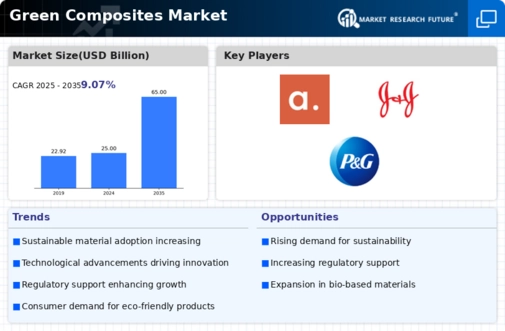Market Share
Green Composites Market Share Analysis
The Green Composites market has adopted several strategies aimed at positioning it strategically and increasing its market share. One fundamental strategy commonly used by green composite manufacturers is product differentiation, which separates their products from those made by competing firms operating within similar industry segmentations. This involves developing unique formulations, optimizing material properties, or creating specialized composite products tailored to specific applications. Pricing plays a crucial role in determining where green composites sit within the market landscape. To capture bigger slices of the sustainable consumption pie by offering eco-friendly, cost-effective solutions, companies may adopt competitive pricing geared towards price-sensitive customers who are looking for quality but cannot afford to pay much more than what it costs to produce equivalent conventional commodity items of similar quality standards leading its poor performance rates against environmental friendlier alternatives resulting into lesser sales volume unlike those brands using premium prices to position themselves as providers high-grade ecological materials for discriminating consumers who are willing pay the extra money per unit sold justifiable reasons, i.e., reduced energy consumption during production processes associated with environmentally friendly lifestyles. Therefore, a balance has to be struck between sustainability and pricing for a brand to thrive in the market. Distribution channels are very important in positioning Green Composites' market share. Green Composites are available widely by establishing strong relationships with distributors, manufacturers, and end users. Thus, it becomes easy for customers to find Green Branding publicity campaigns and strategies in marketing, which are fundamental components of market share positioning in the Green Composites industry. Companies should have a well-developed brand image that is associated with sustainability because this can greatly influence customer preferences. Marketing initiatives that are specific, like environmentally friendly advertisements, taking part in sustainable development events, and online promotions, help improve its visibility and increase product recall, hence increasing market share. Dynamic Green Composites markets require companies to be innovative as well as adaptable. They can be leaders by maintaining their technological advancements and monitoring trends in sustainability. Additionally, strategic partnerships and collaborations also highly influence market share positioning for the Green Composites industry. This rod can lead to synergies that will enhance product quality and streamline production processes, resulting in competitive industrial complexes; such cooperation frameworks may include alliances among other players within the sector as raw material suppliers or research institutions. Global market dynamics, together with regional considerations, are factors essential to market share positioning for green composites. It enables firms to focus on markets through customization strategies after understanding the unique needs/preferences of distinct regions, thereby making them more targeted and effective.






Leave a Comment